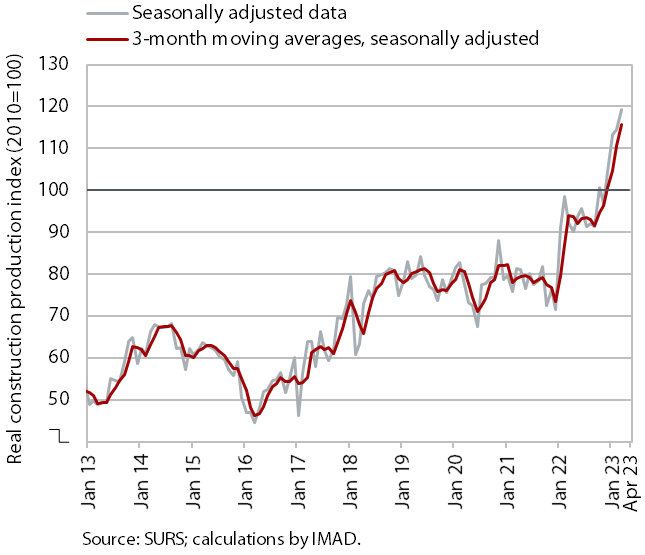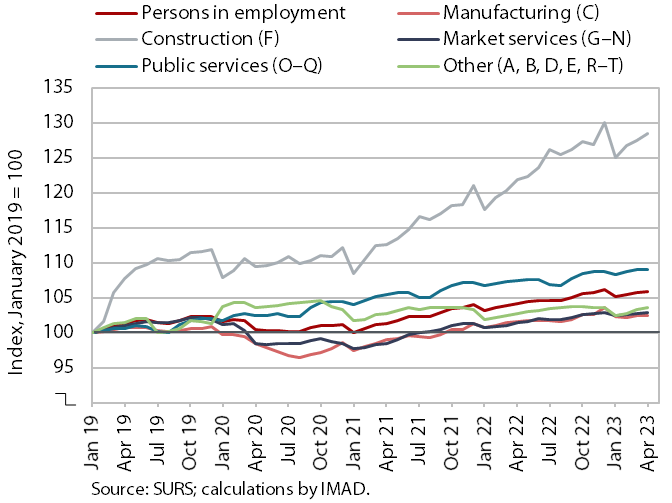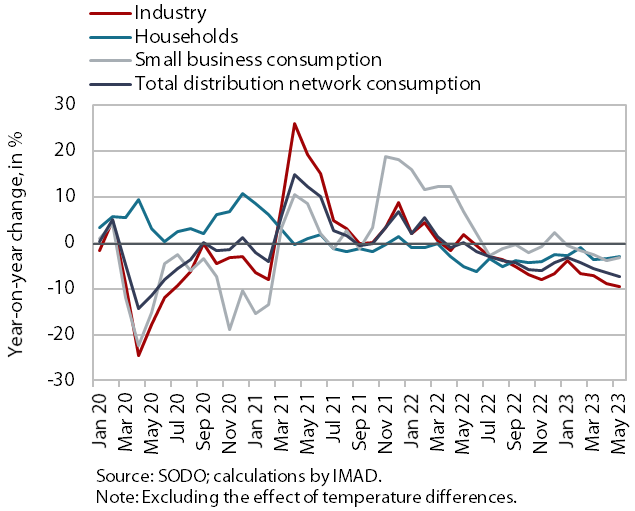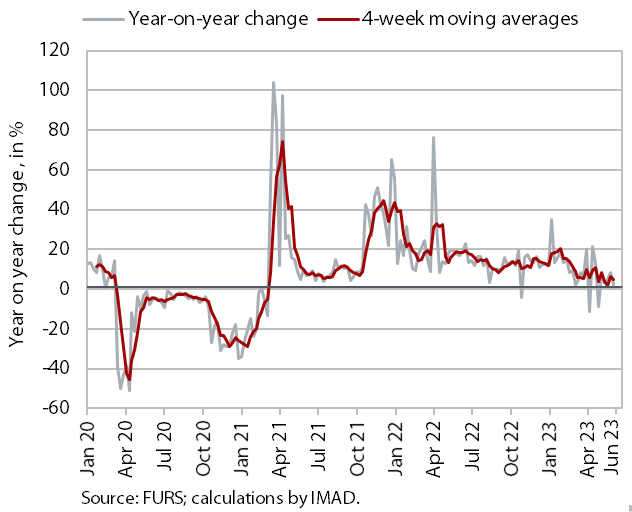Charts of the Week
Charts of the week from 12 to 16 June 2023: current account of the balance of payments, activity in construction, number of persons in employment and other charts
The current account surplus continued to increase in April, mainly due to the trends in trade in goods. The year-on-year increase was mainly due to a higher surplus in trade in services. Despite a decline in April, the value of construction put in place remains high. In the first four months, it increased in all segments and was 24% higher year-on-year. Year-on-year growth in the number of persons in employment in April was slightly lower than in the previous months, mainly due to a year-on-year decrease in the number of civil servants. Electricity consumption was down in all consumer groups in May, most markedly in industry. Given the sharp rise in prices, the value of fiscally verified invoices at the end of May and the beginning of June was 5% higher year-on-year in nominal terms, which is a similar increase as in the previous 14-day period. Growth continued to be highest in the sale of motor vehicles.
Current account of the balance of payments, April 2023

The surplus of the current account of the balance of payments increased again in April, mainly due to the trends in trade in goods. The trade surplus widened in April, as imports fell more than exports. The 12-month current account surplus was also higher than a year earlier, amounting to EUR 1,066.4 million (1.6% of estimated GDP). The year-on-year increase was mainly due to a higher surplus in services trade, especially in trade in travel and transportation services. Growth in the surplus in services trade was also driven by trade in higher value-added services (financial services, telecommunications, computer and information services, and research and development services). The primary income deficit was lower mainly due to lower payments of dividends and profits to foreign investors, and partly due to higher subsidies for the agricultural and fisheries policy from the EU budget. Although the trade balance is improving this year, the 12-month trade deficit was higher than last year. The secondary income deficit was also higher, due to lower government sector transfers from abroad (funds for current international cooperation from the EU budget).
Activity in construction, April 2023

According to data on the value of construction work put in place, construction activity remains high. After increasing at the beginning of this year, the value of construction put in place fell in April, while it is still significantly higher than in April last year (by 23%). In the first four months, activity was 24% higher than last year, with a similar growth in all three segments covered by the statistics: construction of buildings, civil engineering and specialised construction activities.
However, some other data suggest significantly lower growth in construction activity. According to VAT data, the activity of construction companies in April was 12% higher than last year. Based on data on the value of construction put in place, the difference in the growth of activity was 11 p.p. Data on the value of industrial production in two activities traditionally strongly linked to construction also do not point to such high growth. Production in other mining and quarrying was 7% lower in April than in the same month of 2022, while it was 18% lower in the manufacture of other non-metallic mineral products.
Number of persons in employment, April 2023

Year-on-year growth in the number of persons in employment was slightly lower in April than in the previous months (1.6%). This was mainly due to the year-on-year decrease in the number of civil servants. The strongest year-on-year growth was still seen in construction, which is facing a major labour shortage and saw the largest increase in the number of persons in employment also compared to the same period in 2019. Employment of foreign workers has been the largest contributor to the overall growth in the number of persons in employment for some time – their contribution was 87% year-on-year in April, slightly higher than in previous months. Foreigners accounted for 14.3% of total employment, up 1.2 p.p. from the previous year. The sectors with the highest share of foreigners were construction (48%), transportation and storage (32%), and administrative and support service activities (26%).
Electricity consumption by consumption group, May 2023

In May, electricity consumption in the distribution network was lower year-on-year in all consumption groups. As in previous few months, the largest decrease was seen in industrial consumption (by 9.6%), according to our estimation mainly on account of the energy-intensive part of the economy. Household consumption was also lower year-on-year in May (by 3.1%), according to our estimates due to a more rational energy consumption. Small business consumption was 3.2% lower year-on-year in May.
Value of fiscally verified invoices, in nominal terms, 28 May–10 June 2023

Amid high price growth, the nominal value of fiscally verified invoices between 28 May and 10 June 2023 was 5% higher year-on-year. Growth was similar as in the previous 14-day period, mainly due to a 5% growth of turnover in trade, which accounted for 76% of the total value of fiscally verified invoices issued. As has been the case all year, growth was highest in the sale of motor vehicles (22%). Growth in retail trade was 3%, while turnover in wholesale trade was similar to last year. After halving in the previous period (to 5%) turnover growth in accommodation and food service activities and in certain creative, arts, entertainment, and sports services and betting and gambling rebounded (overall growth was 11%).
